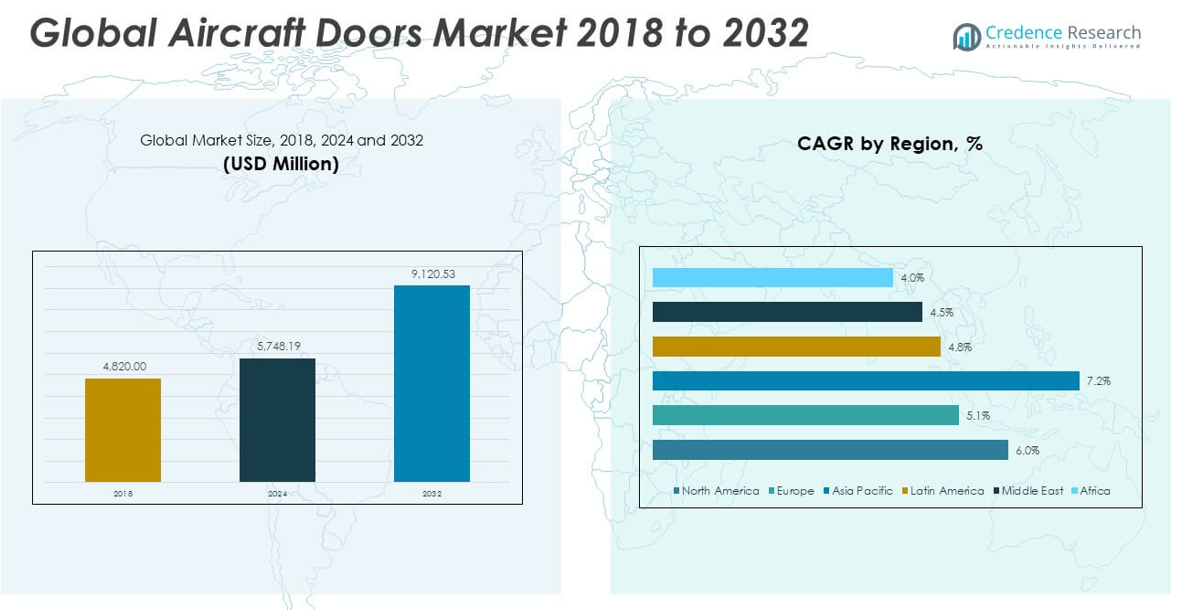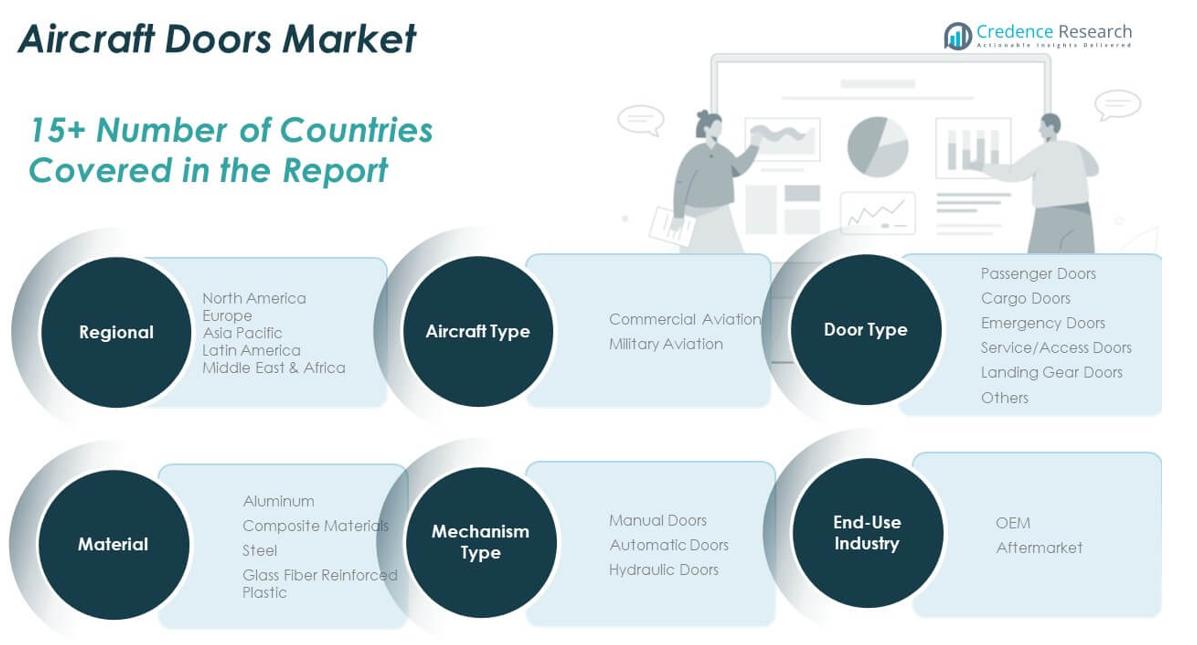CHAPTER NO. 1 : GENESIS OF THE MARKET
1.1 Market Prelude – Introduction & Scope
1.2 The Big Picture – Objectives & Vision
1.3 Strategic Edge – Unique Value Proposition
1.4 Stakeholder Compass – Key Beneficiaries
CHAPTER NO. 2 : EXECUTIVE LENS
2.1 Pulse of the Industry – Market Snapshot
2.2 Growth Arc – Revenue Projections (USD Million)
2.3. Premium Insights – Based on Primary Interviews
CHAPTER NO. 3 : AIRPORT DOORS MARKET FORCES & INDUSTRY PULSE
3.1 Foundations of Change – Market Overview
3.2 Catalysts of Expansion – Key Market Drivers
3.2.1 Momentum Boosters – Growth Triggers
3.2.2 Innovation Fuel – Disruptive Technologies
3.3 Headwinds & Crosswinds – Market Restraints
3.3.1 Regulatory Tides – Compliance Challenges
3.3.2 Economic Frictions – Inflationary Pressures
3.4 Untapped Horizons – Growth Potential & Opportunities
3.5 Strategic Navigation – Industry Frameworks
3.5.1 Market Equilibrium – Porter’s Five Forces
3.5.2 Ecosystem Dynamics – Value Chain Analysis
3.5.3 Macro Forces – PESTEL Breakdown
3.6 Price Trend Analysis
3.6.1 Regional Price Trend
3.6.2 Price Trend by product
CHAPTER NO. 4 : KEY INVESTMENT EPICENTER
4.1 Regional Goldmines – High-Growth Geographies
4.2 Product Frontiers – Lucrative Product Categories
4.3 Door Type Sweet Spots – Emerging Demand Segments
CHAPTER NO. 5: REVENUE TRAJECTORY & WEALTH MAPPING
5.1 Momentum Metrics – Forecast & Growth Curves
5.2 Regional Revenue Footprint – Market Share Insights
5.3 Segmental Wealth Flow – Type & Door Type Revenue
CHAPTER NO. 6 : TRADE & COMMERCE ANALYSIS
6.1. Import Analysis by Region
6.1.1. Global Airport Doors Market Import Revenue By Region
6.2. Export Analysis by Region
6.2.1. Global Airport Doors Market Export Revenue By Region
CHAPTER NO. 7 : COMPETITION ANALYSIS
7.1. Company Market Share Analysis
7.1.1. Global Airport Doors Market: Company Market Share
7.2. Global Airport Doors Market Company Revenue Market Share
7.3. Strategic Developments
7.3.1. Acquisitions & Mergers
7.3.2. New Product Launch
7.3.3. Regional Expansion
7.4. Competitive Dashboard
7.5. Company Assessment Metrics, 2024
CHAPTER NO. 8 : AIRPORT DOORS MARKET – BY AIRCRAFT TYPE SEGMENT ANALYSIS
8.1. Airport Doors Market Overview by Type Segment
8.1.1. Airport Doors Market Revenue Share By Type
8.2. Commercial Aviation
8.2.1 Narrow-Body Aircraft
8.2.2 Wide-Body Aircraft
8.2.3 Regional Aircraft
8.2.4 Business Jets
8.2.5 Very Large Aircraft
8.3. Military Aviation
8.3.1 Transport Aircraft
8.3.2 Military Helicopters
CHAPTER NO. 9 : AIRPORT DOORS MARKET – BY DOOR TYPE SEGMENT ANALYSIS
9.1. Airport Doors Market Overview by Door Type Segment
9.1.1. Airport Doors Market Revenue Share By Door Type
9.2. Passenger Doors
9.3. Cargo Doors
9.4. Emergency Doors
9.5. Service/Access Doors
9.6. Landing Gear Doors
9.7.. Others
CHAPTER NO. 10 : AIRPORT DOORS MARKET – BY MATERIAL SEGMENT ANALYSIS
10.1. Airport Doors Market Overview by Material Segment
10.1.1. Airport Doors Market Revenue Share By Material
10.2. Aluminium
10.3. Composite Materials
10.4. Steel
10.5. Glass Fiber Reinforced Plastic
CHAPTER NO. 11 : AIRPORT DOORS MARKET – BY MECHANISM TYPE SEGMENT ANALYSIS
11.1. Airport Doors Market Overview by Mechanism Type Segment
11.1.1. Airport Doors Market Revenue Share By Mechanism Type
11.2. Manual Doors
11.3. Automatic Doors
11.4. Hydraulic Doors
CHAPTER NO. 12 : AIRPORT DOORS MARKET – BY END USE INDUSTRY SEGMENT ANALYSIS
12.1. Airport Doors Market Overview by End Use Industry Segment
12.1.1. Airport Doors Market Revenue Share By End Use Industry
12.2. OEM
12.3. Aftermarket
CHAPTER NO. 13 : AIRPORT DOORS MARKET – REGIONAL ANALYSIS
13.1. Airport Doors Market Overview by Region Segment
13.1.1. Global Airport Doors Market Revenue Share By Region
13.1.2. Regions
13.1.3. Global Airport Doors Market Revenue By Region
13.1.4. Type
13.1.5. Global Airport Doors Market Revenue By Type
13.1.6. Door Type
13.1.7. Global Airport Doors Market Revenue By Door Type
13.1.8. Material
13.1.9. Global Airport Doors Market Revenue By Material
13.1.10. Mechanism Type
13.1.12. Global Airport Doors Market Revenue By Mechanism Type
13.1.13. End Use Industry
13.1.14. Global Airport Doors Market Revenue By End Use Industry
CHAPTER NO. 14 : NORTH AMERICA AIRPORT DOORS MARKET – COUNTRY ANALYSIS
14.1. North America Airport Doors Market Overview by Country Segment
14.1.1. North America Airport Doors Market Revenue Share By Region
14.2. North America
14.2.1. North America Airport Doors Market Revenue By Country
14.2.2. Type
14.2.3. North America Airport Doors Market Revenue By Type
14.2.4. Door Type
14.2.5. North America Airport Doors Market Revenue By Door Type
14.2.6. Material
14.2.7. North America Airport Doors Market Revenue By Material
14.2.8. Mechanism Type
14.2.9. North America Airport Doors Market Revenue By Mechanism Type
14.2.10. End Use Industry
14.2.11. North America Airport Doors Market Revenue By End Use Industry
14.3. U.S.
14.4. Canada
14.5. Mexico
CHAPTER NO. 15 : EUROPE AIRPORT DOORS MARKET – COUNTRY ANALYSIS
15.1. Europe Airport Doors Market Overview by Country Segment
15.1.1. Europe Airport Doors Market Revenue Share By Region
15.2. Europe
15.2.1. Europe Airport Doors Market Revenue By Country
15.2.2. Type
15.2.3. Europe Airport Doors Market Revenue By Type
15.2.4. Door Type
15.2.5. Europe Airport Doors Market Revenue By Door Type
15.2.6. Material
15.2.7. Europe Airport Doors Market Revenue By Material
15.2.8. Mechanism Type
15.2.9. Europe Airport Doors Market Revenue By Mechanism Type
15.2.10. End Use Industry
15.2.11. Europe Airport Doors Market Revenue By End Use Industry
15.3. UK
15.4. France
15.5. Germany
15.6. Italy
15.7. Spain
15.8. Russia
15.9. Rest of Europe
CHAPTER NO. 16 : ASIA PACIFIC AIRPORT DOORS MARKET – COUNTRY ANALYSIS
16.1. Asia Pacific Airport Doors Market Overview by Country Segment
16.1.1. Asia Pacific Airport Doors Market Revenue Share By Region
16.2. Asia Pacific
16.2.1. Asia Pacific Airport Doors Market Revenue By Country
16.2.2. Type
16.2.3. Asia Pacific Airport Doors Market Revenue By Type
16.2.4. Door Type
16.2.5. Asia Pacific Airport Doors Market Revenue By Door Type
16.2.6. Material
16.2.7. Asia Pacific Airport Doors Market Revenue By Material
16.2.8. Mechanism Type
16.2.9. Asia Pacific Airport Doors Market Revenue By Mechanism Type
16.2.10. End Use Industry
16.2.11. Asia Pacific Airport Doors Market Revenue By End Use Industry
16.3. China
16.4. Japan
16.5. South Korea
16.6. India
16.7. Australia
16.8. Southeast Asia
16.9. Rest of Asia Pacific
CHAPTER NO. 17 : LATIN AMERICA AIRPORT DOORS MARKET – COUNTRY ANALYSIS
17.1. Latin America Airport Doors Market Overview by Country Segment
17.1.1. Latin America Airport Doors Market Revenue Share By Region
17.2. Latin America
17.2.1. Latin America Airport Doors Market Revenue By Country
17.2.2. Type
17.2.3. Latin America Airport Doors Market Revenue By Type
17.2.4. Door Type
17.2.5. Latin America Airport Doors Market Revenue By Door Type
17.2.6. Material
17.2.7. Latin America Airport Doors Market Revenue By Material
17.2.8. Mechanism Type
17.2.9. Latin America Airport Doors Market Revenue By Mechanism Type
17.2.10. End Use Industry
17.2.11. Latin America Airport Doors Market Revenue By End Use Industry
17.3. Brazil
17.4. Argentina
17.5. Rest of Latin America
CHAPTER NO. 18 : MIDDLE EAST AIRPORT DOORS MARKET – COUNTRY ANALYSIS
18.1. Middle East Airport Doors Market Overview by Country Segment
18.1.1. Middle East Airport Doors Market Revenue Share By Region
18.2. Middle East
18.2.1. Middle East Airport Doors Market Revenue By Country
18.2.2. Type
18.2.3. Middle East Airport Doors Market Revenue By Type
18.2.4. Door Type
18.2.5. Middle East Airport Doors Market Revenue By Door Type
18.2.6. Material
18.2.7. Middle East Airport Doors Market Revenue By Material
18.2.8. Mechanism Type
18.2.9. Middle East Airport Doors Market Revenue By Mechanism Type
18.2.10. End Use Industry
18.2.11. Middle East Airport Doors Market Revenue By End Use Industry
18.3. GCC Countries
18.4. Israel
18.5. Turkey
18.6. Rest of Middle East
CHAPTER NO. 19 : AFRICA AIRPORT DOORS MARKET – COUNTRY ANALYSIS
19.1. Africa Airport Doors Market Overview by Country Segment
19.1.1. Africa Airport Doors Market Revenue Share By Region
19.2. Africa
19.2.1. Africa Airport Doors Market Revenue By Country
19.2.2. Type
19.2.3. Africa Airport Doors Market Revenue By Type
19.2.4. Door Type
19.2.5. Africa Airport Doors Market Revenue By Door Type
19.2.6. Material
19.2.7. Africa Airport Doors Market Revenue By Material
19.2.8. Mechanism Type
19.2.9. Africa Airport Doors Market Revenue By Mechanism Type
19.2.10. End Use Industry
19.2.11. Africa Airport Doors Market Revenue By End Use Industry
19.3. South Africa
19.4. Egypt
19.5. Rest of Africa
CHAPTER NO. 20 : COMPANY PROFILES
20.1. Aernnova Aerospace S.A. (Spain)
20.1.1. Company Overview
20.1.2. Product Portfolio
20.1.3. Financial Overview
20.1.4. Recent Developments
20.1.5. Growth Strategy
20.1.6. SWOT Analysis
20.2. Safran (France)
20.3. LATECOERE (France)
20.4. GKN Aerospace (United Kingdom)
20.5. Collins Aerospace (United States)
20.6. SICAMB S.p.A (Italy)
20.7. Hellenic Aerospace Industry (Greece)
20.8. Terma Group (Denmark)
20.9. SAAB AB (Sweden)
20.10. Triumph Group (United States)
20.11. Elbit Systems Ltd. (Israel)
20.12. Mitsubishi Heavy Industries Ltd. (Japan)
20.13. Daher (France)
20.14. Airbus Helicopter SAS (France)
20.15. AVIC International Holding Corporation (China)
20.16. PCC Aerostructures (United States)
20.17. The Atlas Group (United States)
20.18. Hindustan Aeronautics Limited (India)





